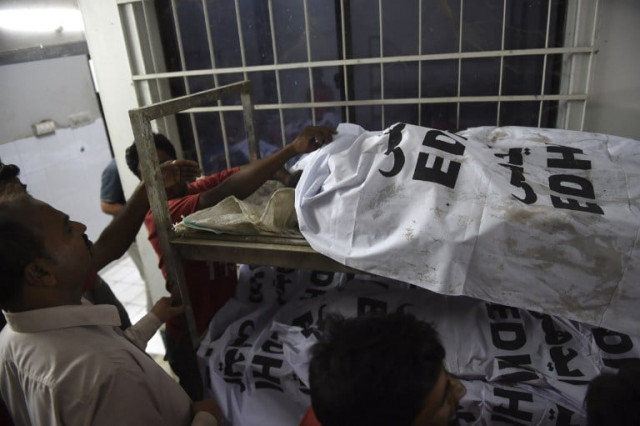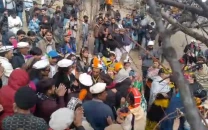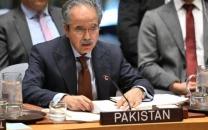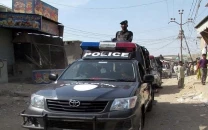Nowhere to keep the dead
Hazara’s biggest tertiary care hospital lacks proper mortuary

The biggest tertiary care hospital in Hazara lacks a mortuary. PHOTO: AFP
The facility, also known as Ayub Teaching Hospital (ATH), is the fourth autonomous tertiary care hospital in the province and is being managed by a board of governors under the MTI Act, 2016. According to official records, AMC is a 1,000-bed facility with about 2,000 daily OPD visitors. It hosts 50 to 80 elective surgeries every day and handles patients from across Hazara division, which has a population of over eight million, and also patients from parts of G-B and AJK.

Despite its raw size, it has no mortuary. Because of this, in the recent past, the hospital sometimes has to ‘dispose of’ unclaimed bodies of those died in the hospital or were from far-flung areas. Sources said the hospital conduct at least five to six postmortems in a week and only has a postmortem room to work out of. In the absence of a mortuary, the hospital administration has faced at least two crisis situations since its establishment.
Apathy of govt: District Headquarters Teaching Hospital lacks beds
“I found the hospital administration helpless after the Kashmir earthquake of 2005 when the canteen floor was filled with bodies, and then on the night of December 7, 2016, after Havelian plane crash,” claimed K-P People Doctors Association spokesperson Dr Daud Iqbal.
He said hospital staff had no option but to place the remains of the 47 plane crash victims on the floor in the basement of an under-construction ward.
He said that when the provincial govt was aware of the facilities available at ATH it should not have shifted the bodies to Abbottabad, where there was no mortuary and nor DNA test. Dr Iqbal lambasted the ATH administration for being visionless and believing in ad-hocism, adding that when the hospital administration could spend millions on the construction of a gate next to the casualty department without any need for it, and when it could spend millions on restricting the movement of patients’ attendants, it could better utilise public money on improving treatment facilities and adding a mortuary. He noted that none of the district headquarter hospitals in the division have a mortuary either.

He said that after the 2005 earthquake, senior doctors asked the then-administration and the provincial government to build a mortuary, but no action was taken and the hospital administration had to face public criticism for the poor arrangements. He said that construction of a mortuary would not cost much as they have space and buildings available and only need cold storage.
“It’s true, ATH lacks a properly equipped mortuary and has only postmortem rooms which can handle six bodies at a time,” said Provincial Doctors Association President Dr Aminullah Afridi.
He added that despite the fact the ATH has a fully-equipped forensics department, the lack of a mortuary limits its purpose to teaching activities at Ayub Medical College. Another problem he pointed out was the lack of medico-legal cases officers.
He noted that Khyber Teaching Hospital, Peshawar was the only tertiary care hospital in K-P with a mortuary. The KTH morgue can handle up to 20 bodies.
Muhammad Shaukat, an official at Edhi Centre, Haripur, said the centre receives two to three unclaimed bodies every month. If they are mutilated r decaying, they are buried at a public graveyard near Railway station, while fresh corpses may be displayed at public places in Edhi vans for possible identification. He said the centre buried 38 unclaimed bodies, six of which were later shifted after their relatives identified them from pictures released by the Edhi Centre.
Keeping an eye: CM pays surprise visit to hospital
Dr Tariq, a medical officer at a public sector health facility, said that according to international standard operating procedures (SOP) the bodies should be kept in properly maintained cold storage as long as the investigation is ongoing, adding that freezers should also be available at teaching hospitals. He said that for traceability and identification, bodies should be tagged with hospital numbers and records made both electronically and manually to reduce the chance of errors.
ATH Medical Director Dr Salim Afzal was not available for comment, but former hospital director and ATH BoG Secretary Dr Siddique Rehman said the hospital has a mortuary-cum-postmortem room with space for six bodies. “We are living in a Muslim society where the burial of bodies is hardly delayed, and even if needed, only for a very limited time,” he said, adding that expansion would still be taken up with the provincial govt. He claimed the crash victims’ bodies were respectfully placed in the basement area but had to be flown to PIMS as ATH has no DNA testing facility.
Published in The Express Tribune, December 24th, 2016.



















COMMENTS
Comments are moderated and generally will be posted if they are on-topic and not abusive.
For more information, please see our Comments FAQ